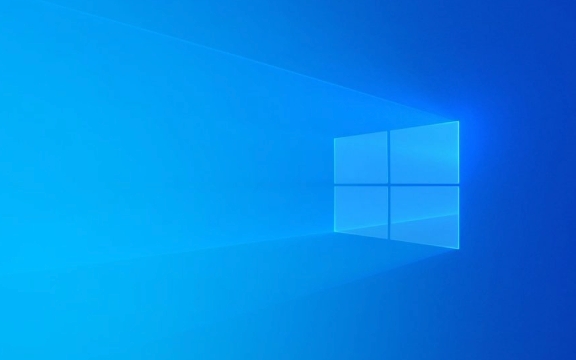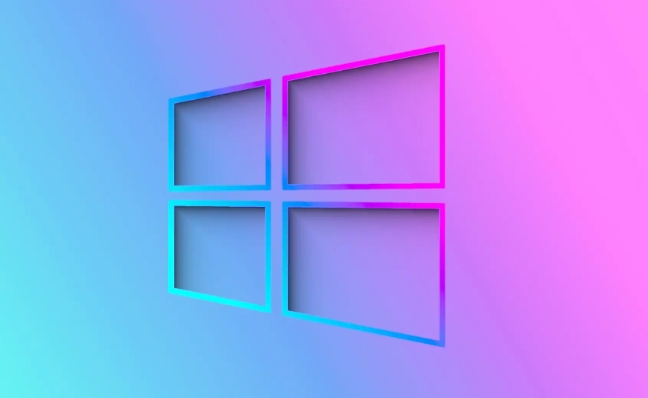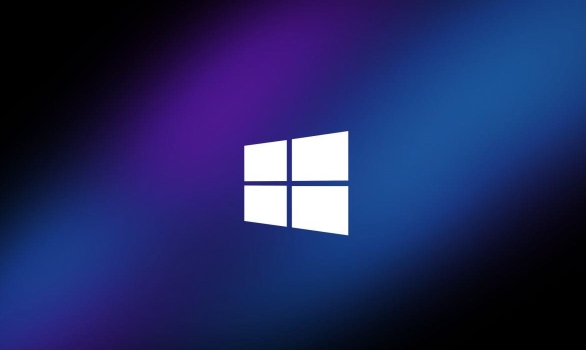Update the graphics driver: Download the latest driver through the device manager or the official website, and use the DDU tool to completely reinstall it if necessary; 2. Turn off hardware acceleration: Disable hardware acceleration in Chrome and other applications and system graphics settings to avoid conflicts; 3. Adjust the refresh rate: Set the refresh rate to the recommended value in the display settings (such as 60Hz or higher); 4. Check system updates: Install the latest patch or uninstall the KB update that causes problems; 5. Disable transparent effect: Turn off the color transparency effect in personalized settings, or adjust the performance options for the best performance; 6. Troubleshoot hardware problems: Replace the connection cable, test other monitors or check the screen cable. If it is still invalid, create a new user account to exclude configuration damage. Most problems are caused by the driver or settings. Prioritize these two items to solve 90% of the situation.

Windows 10 screen flashing or splashing is a common but troublesome problem, usually related to graphics card drivers, system settings, or third-party software. While it may happen on any device, it can be solved in most cases with some simple ways. The following are several common causes and corresponding solutions.

1. Check and update the graphics card driver
Incompatible or outdated graphics card drivers are the most common causes of screen flickering, especially NVIDIA, AMD, or Intel integrated graphics cards.
Solution:

- Press
Win Xand select Device Manager . - Expand the display adapter .
- Right-click on your graphics card (such as Intel UHD Graphics, NVIDIA GeForce, etc.) and select Update Driver .
- Select Automatically search for updated drivers .
Tip : You can also go to the official website of the graphics card manufacturer (such as the Intel driver support page, NVIDIA official website or AMD official website) to download the latest driver and install it manually. Use DDU (Display Driver Uninstaller) to completely uninstall the old driver in safe mode and then reinstall it for better results.
2. Turn off the "Hardware Acceleration" function
Many applications (such as Chrome, Microsoft Teams, Discord, etc.) use hardware acceleration to improve performance, but sometimes conflict with graphics card drivers, causing the screen to flash.

How to turn off hardware acceleration:
-
Chrome browser :
- Click the three dot menu in the upper right corner → Settings .
- Go to System → Turn off Using Hardware Acceleration Mode (if available) .
- Restart the browser.
-
Windows system level settings :
- Open Settings → System → Display .
- Scroll to the bottom and click Graphic Settings .
- Turn off the hardware-accelerated GPU plan (if enabled).
It is recommended to turn off hardware acceleration for suspicious applications one by one to see if the problem is solved.
3. Adjust the monitor refresh rate
Incorrect refresh rates can cause the screen to flicker, especially when external displays are connected.
Operation steps:
- Right-click on desktop → display settings .
- Scroll to the bottom → Click Advanced Display Settings .
- To view the current monitor, click the Refresh Rate drop-down menu.
- Select the recommended refresh rate (usually 60Hz or higher, such as 75Hz, 144Hz).
If you are using an external laptop monitor, make sure the cable (HDMI/DP) supports high refresh rate.
4. Check for system updates or patch conflicts
Some Windows 10 updates may cause compatibility issues, especially cumulative updates.
Suggested practices:
- Open Settings → Update and Security → Windows Update and install all available updates (new patches may fix old issues).
- If the problem occurs after an update, try:
- Uninstall recent updates: Settings → Updates and Security → Recover → Fallback to earlier versions (if still within 10 days).
- Or remove the recently installed KB update in View Update History → Uninstall Updates .
5. Disable Transparent Effects and Visual Effects
Windows 10's visual effects can sometimes cause rendering issues, especially on older devices.
Close method:
- Open Settings → Personalization → Color .
- Turn off the transparent effect .
- (Optional) Right-click "This Computer" → Properties → Advanced System Settings → Performance → Settings → Select Adjust to Optimize Performance or Turn off the special effects manually.
6. Check the hardware problems of the monitor or cable
If the flashing occurs only when the external monitor is connected, it may be loose cables, damaged or the monitor itself malfunction.
Troubleshooting suggestions:
- Replace HDMI/DisplayPort line test.
- Try connecting to another monitor or TV.
- Check if the notebook screen is flashing when it is moving (maybe poor cable contact).
Basically that's it. Most screen flickering problems are caused by the driver or software settings. Priority is given to updating the graphics card driver and turning off hardware acceleration, and 90% of the cases can be solved. If all methods are invalid, consider temporarily creating a new user account test to rule out the possibility of corruption of the configuration file.
The above is the detailed content of Windows 10 screen flickering or flashing. For more information, please follow other related articles on the PHP Chinese website!

Hot AI Tools

Undress AI Tool
Undress images for free

Undresser.AI Undress
AI-powered app for creating realistic nude photos

AI Clothes Remover
Online AI tool for removing clothes from photos.

Clothoff.io
AI clothes remover

Video Face Swap
Swap faces in any video effortlessly with our completely free AI face swap tool!

Hot Article

Hot Tools

Notepad++7.3.1
Easy-to-use and free code editor

SublimeText3 Chinese version
Chinese version, very easy to use

Zend Studio 13.0.1
Powerful PHP integrated development environment

Dreamweaver CS6
Visual web development tools

SublimeText3 Mac version
God-level code editing software (SublimeText3)

Hot Topics
 Windows 11 slow boot time fix
Jul 04, 2025 am 02:04 AM
Windows 11 slow boot time fix
Jul 04, 2025 am 02:04 AM
The problem of slow booting can be solved by the following methods: 1. Check and disable unnecessary booting programs; 2. Turn off the quick boot function; 3. Update the driver and check disk health; 4. Adjust the number of processor cores (only for advanced users). For Windows 11 systems, first, the default self-start software such as QQ and WeChat are disabled through the task manager to improve the startup speed; if you use dual systems or old hardware, you can enter the power option to turn off the quick boot function; second, use the device manager to update the driver and run the chkdsk command to fix disk errors, and it is recommended to replace the mechanical hard disk with SSD; for multi-core CPU users, the kernel parameters can be adjusted through bcdedit and msconfig to optimize the startup efficiency. Most cases can be corrected by basic investigation
 How to Change Font Color on Desktop Icons (Windows 11)
Jul 07, 2025 pm 12:07 PM
How to Change Font Color on Desktop Icons (Windows 11)
Jul 07, 2025 pm 12:07 PM
If you're having trouble reading your desktop icons' text or simply want to personalize your desktop look, you may be looking for a way to change the font color on desktop icons in Windows 11. Unfortunately, Windows 11 doesn't offer an easy built-in
 Fixed Windows 11 Google Chrome not opening
Jul 08, 2025 pm 02:36 PM
Fixed Windows 11 Google Chrome not opening
Jul 08, 2025 pm 02:36 PM
Fixed Windows 11 Google Chrome not opening Google Chrome is the most popular browser right now, but even it sometimes requires help to open on Windows. Then follow the on-screen instructions to complete the process. After completing the above steps, launch Google Chrome again to see if it works properly now. 5. Delete Chrome User Profile If you are still having problems, it may be time to delete Chrome User Profile. This will delete all your personal information, so be sure to back up all relevant data. Typically, you delete the Chrome user profile through the browser itself. But given that you can't open it, here's another way: Turn on Windo
 How to fix second monitor not detected in Windows?
Jul 12, 2025 am 02:27 AM
How to fix second monitor not detected in Windows?
Jul 12, 2025 am 02:27 AM
When Windows cannot detect a second monitor, first check whether the physical connection is normal, including power supply, cable plug-in and interface compatibility, and try to replace the cable or adapter; secondly, update or reinstall the graphics card driver through the Device Manager, and roll back the driver version if necessary; then manually click "Detection" in the display settings to identify the monitor to confirm whether it is correctly identified by the system; finally check whether the monitor input source is switched to the corresponding interface, and confirm whether the graphics card output port connected to the cable is correct. Following the above steps to check in turn, most dual-screen recognition problems can usually be solved.
 Fixed the failure to upload files in Windows Google Chrome
Jul 08, 2025 pm 02:33 PM
Fixed the failure to upload files in Windows Google Chrome
Jul 08, 2025 pm 02:33 PM
Have problems uploading files in Google Chrome? This may be annoying, right? Whether you are attaching documents to emails, sharing images on social media, or submitting important files for work or school, a smooth file upload process is crucial. So, it can be frustrating if your file uploads continue to fail in Chrome on Windows PC. If you're not ready to give up your favorite browser, here are some tips for fixes that can't upload files on Windows Google Chrome 1. Start with Universal Repair Before we learn about any advanced troubleshooting tips, it's best to try some of the basic solutions mentioned below. Troubleshooting Internet connection issues: Internet connection
 Want to Build an Everyday Work Desktop? Get a Mini PC Instead
Jul 08, 2025 am 06:03 AM
Want to Build an Everyday Work Desktop? Get a Mini PC Instead
Jul 08, 2025 am 06:03 AM
Mini PCs have undergone
 Is the latest Windows update safe to install
Jul 02, 2025 am 01:04 AM
Is the latest Windows update safe to install
Jul 02, 2025 am 01:04 AM
Microsoft's latest Windows updates can generally be installed safely, but they need to be judged based on the update type and usage scenario. Ordinary users can update their daily office work, video watching, etc. directly; professional software or game users should be cautious. Regular quality updates (such as the monthly "Tuesday Patch") have low risks, so it is recommended to install them in time; updates to functions (such as large version upgrades) may cause compatibility issues. It is recommended to back up data, confirm software and hardware support, and check community feedback before installing. Overall, quality updates are safe and reliable, and functional updates are suitable for optional installation after observation.







